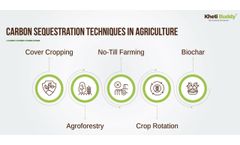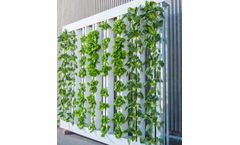Crop Species Articles & Analysis
25 articles found
Physical purity refers to the percentage by weight of pure seed from the crop species under test, excluding foreign matter. This analysis is crucial because seed lots often contain small amounts of other plant species, debris, or damaged seeds collected during harvesting and processing. ...
While farming activities have traditionally been associated with greenhouse gas emissions, innovative practices can turn agriculture into a significant carbon sink. This transformation hinges on effective carbon sequestration techniques, which capture and store atmospheric carbon dioxide in soils and plants. Implementing these methods is crucial in our fight against climate change. However, the ...
Despite continuous improvements in farming practices, current crop yields are growing too slowly to keep up with the predicted increase in food demand. ...
One adaptation strategy Fort Albany First Nation has welcomed is the creation of gardens (funded by that Canadian Institute of Health Research and Climate Change Health and Adaptation Program). As of 2019, over 28 different crop species grew in the Fort Albany First Nation community garden. During crop harvest nutrients are removed from the ...
The action spectrum, absorptance and quantum yield of photosynthesis in crop plants. Agrie. MeteoroL, 9: 191-216. The measurements were made to provide a basis for discussion of the definition of “photo-synthetically active radiation”. The action spectrum, absorptance and spectral quantum yield of CO2 uptake were measured, for leaves of 22 species of ...
It is a series of special fertilizers based on the principle of balanced fertilization, the results of soil nutrient test, crop species, yield index and different soil quality, such as special fertilizer for wheat, special fertilizer for rice, special fertilizer for peanut and potato, etc. ...
Establishment of preferred roosting hosts in crop borders may help improve suppression of fruit fly species by providing sites for bait spray applications. ...
The honey bee, Apis mellifera L. is the most important managed pollinator species worldwide and plays a critical role in pollination of a diverse range of economically important crops. Due to this species' importance to agriculture and its historical use as a surrogate species for pollinators to evaluate the potential adverse ...
He explained how Kenya is building a comprehensive system for estimating land carbon emissions using a wide variety of information, including data on soil, crops, land cover and usage, and daily weather reports. However, he pointed out that climate change competes with a range of other pressing development issues in developing countries. ...
C2H4 production is a natural part of the plant life cycle, a complex hormone that varies not only between species, but from crop to crop of the same species. C2H4 has been called the plant “death hormone”, because as part of the natural plant life cycle it not only accelerates growth and plant maturity, but also ...
Biosolids are an important source of nutrients and organic matter, which are necessary for the productive cultivation of crop plants. Biosolids have been found to contain the personal care products, triclosan and triclocarban, at high concentrations relative to other pharmaceuticals and personal care products. The current study investigates whether exposure of six plant ...
Other objectives for using cover crops include building soil organic matter and increasing biological diversity for soil conditioning and soil health; holding onto and recycling nutrients in the root zone, thus reducing leaching losses; adding nitrogen fertility if the cover crop is a legume species; suppression of weeds that would otherwise ...
The uptake and transport of mercury (Hg) through vegetation play an important role in the biogeochemical cycling of Hg. However, quantitative information regarding Hg translocation in plants is poorly understood. In this study, Hg uptake, accumulation and translocation in four corps rice (Oryza.sativa L.), wheat (Triticum L.), corn (Zea mays L.) and oilseed rape (Brassica campestris L.) grown ...
The relative sensitivity of 17 non‐crop plant species from Oregon's Willamette Valley was determined in response to glyphosate, tribenuron methyl (tribenuron) and fluazifop‐P‐butyl (fluazifop) herbicides. ...
Conservation tillage, besides being more economical, prevents soil erosion and has other beneficial effects on our environment, but few studies have been conducted on differential responses of different crops to conservation tillage. The main objective of this study was to examine the interaction of tillage with crop species. ...
Intercropping can enhance yields and reduce pest infestations, but investigations of intercropping regimes using crop species common to the large-scale monoculture production systems of western Canada have not examined these diverse elements. Intercrops of canola (Brassica napus L.) and wheat (Triticum aestivum L.) were established at three sites in Alberta, ...
Interspecific hybridization is a widely used approach to improve crop species. We are pursuing the possibility of using interspecific hybridization between the turfgrass species colonial bentgrass (Agrostis capillaris L.) and creeping bentgrass (A. stolonifera L.) for the improvement of resistance to the fungal disease dollar spot (Sclerotinia ...
The C4 perennial grasses have many potential virtues as bioenergy crops—high productivity and water use efficiency, multiyear crop cycle that minimizes replanting costs, and wide environmental adaptation. In the productive San Joaquin Valley (SJV) of California, these species also confront high levels of ozone (O3) air pollution. It is often ...
The time necessary for crops to successfully complete reproduction is species and environment dependent. Lifecycles can be completed in a few weeks or take several years depending on the plant species. Crop development is divided into phenophases that are affected primarily by light and temperature changes, interacting with ...
In Brazil, as no-till (NT) crop management expands, there is an increased interest in growing peanut (Arachis hypogaea L.) with this system. However, it is not known if the preceding cover crop species, the amount of straw on the soil surface, or the N supplied to the cover crop will affect peanut grown in a NT system. ...











